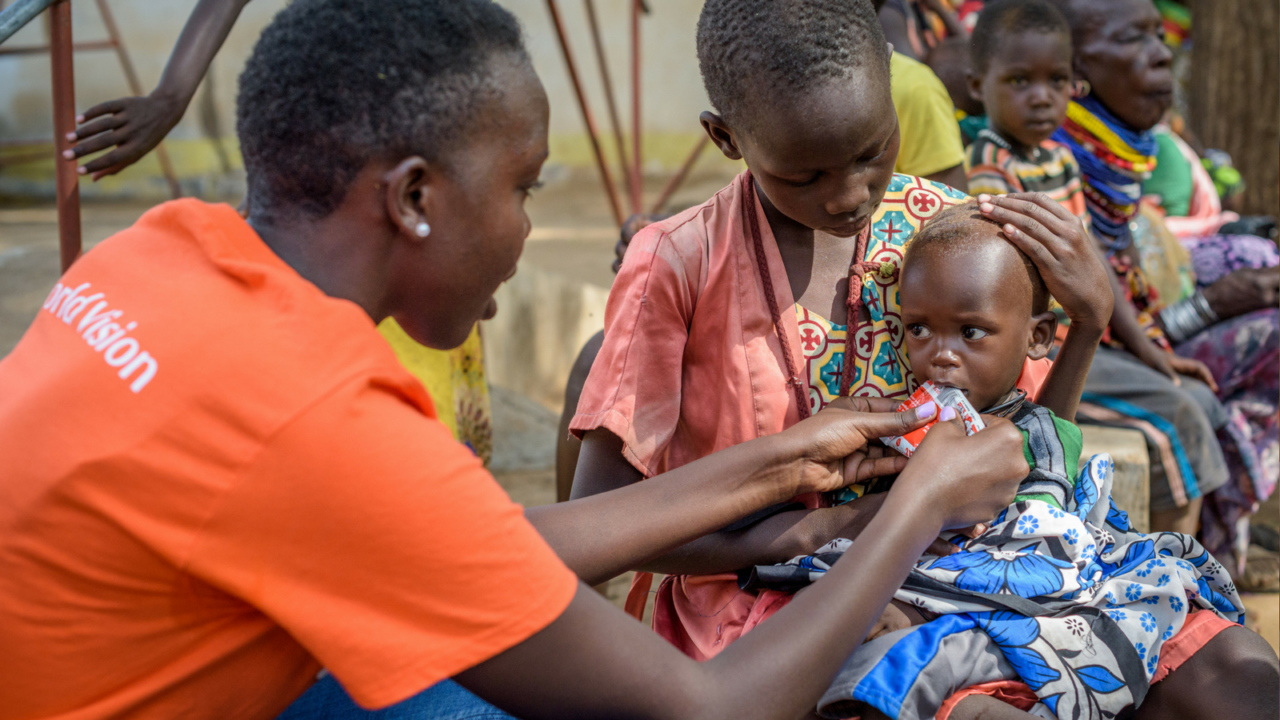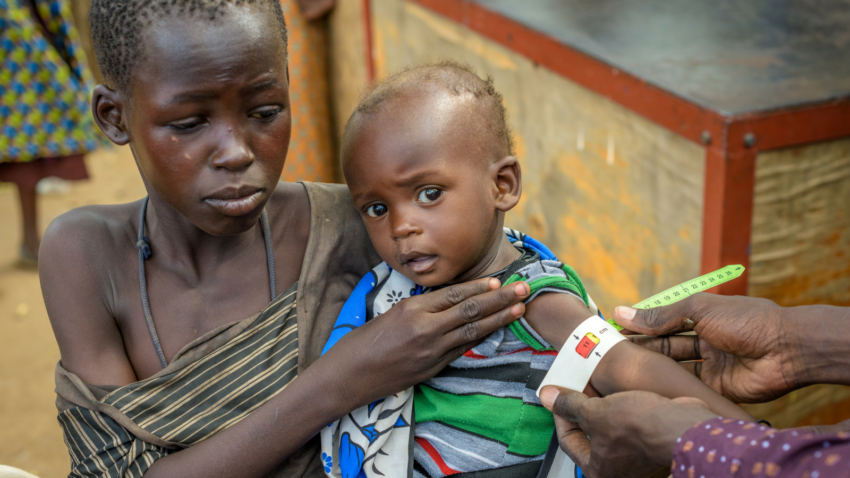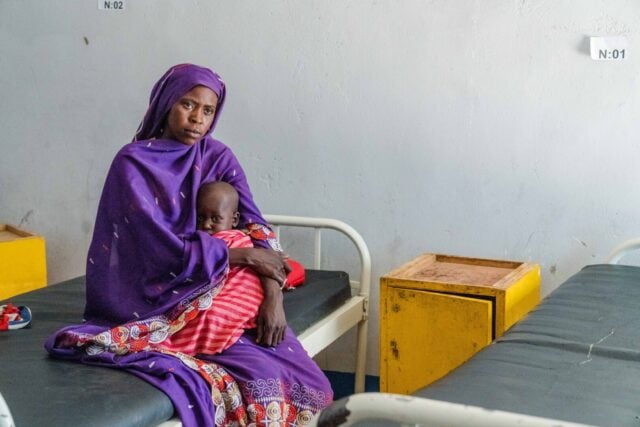Not all stories have happy endings. But sometimes sad endings can change. Meet 9-month-old Akusi in Kenya. During the hunger crisis, she has become severely malnourished.
She is receiving treatment … but her weight is still dropping.
Will you help us change her story?
* * *
This is not a story with a happy ending. But it’s an ending we can change.
Six weeks ago, Akusi’s mother brought her to a health clinic in Lokichoggio, Kenya. Lokichoggio is part of Turkana County, located only 18 miles from the border with South Sudan, a country embroiled in civil war.
Turkana is a place of suffering, with drought and conflict producing a one-two punch that is beating the life out of the people who live here.
Children like 9-month-old Akusi are wasting away. The Global Acute Malnutrition rate, which indicates the severity of a hunger crisis, is 30% in Turkana right now.
“In 100 children, 30 of them are wasted,” explained Lydia Ndung’u, a nutritionist with World Vision. “When a child is wasted, they have lost muscle and fat mass.” Visible signs include a change in hair color and skin luster. Wasting, says Lydia, is a strong predictor of death in children under 5.
Baby Akusi wasn’t thriving. Her mother, Lomukuny, knew why. “When I was pregnant, I had nothing to eat.”
‘When the drought started, it started with a wind’
Lomukuny’s pregnancy had been hard. She had four other children and had just moved to Lokichoggio. “We used to live near the border with our animals, five cattle, and 10 goats,” she says. “Not even one remains.”
People in this county are pastoralists. It’s a beautiful, natural life when there is rain to grow grasses for their camels, cows, donkeys, sheep, and goats to eat. They live simply. Children play. Their parents dance and sing. Families are close. They pray together. But after a succession of droughts, life is no longer beautiful. It’s a nightmare.
The drought has bred conflict over animals, the income source for pastoralists in Turkana. Lomukuny’s husband was caught in the crossfire. Cattle raiders from South Sudan came across the border to the family home in Nadapal, killed her husband, and took most of the family’s animals. The remaining animals died of drought.
Lomukuny was left a single mother of four children between ages 3 and 12, and pregnant with a child who would never know her father. There was nothing to do but find help. They began the 20-mile walk to Lokichoggio.
Lomukuny became malnourished and unwell. “You are hungry, and then you get sick,” she says. Akusi started life with two strikes against her — born to a malnourished mother and without a father to care for her.
Lomukuny named her child “wind.” “When the drought started, it started with a wind. I named her after the wind,” says Lomukuny.
Determined to keep her children alive, Lomukuny began to search for food, leaving Akusi behind with her sisters, 12-year-old Losike and 11-year-old Atoot. The girls would sing their new sister a lullaby to calm her:
“Your mother has traveled a long distance to find food.
She’s going to come soon. Don’t cry.”
But Akusi would cry. “I feel sad when the baby can’t eat,” says Atoot.

Akusi gets treatment for her malnutrition
June Cherutich, 25, a World Vision nutritionist, was on hand to meet Akusi and her worried mother when they arrived at the health center in Lokichoggio. June works three of every four weeks, traveling around the county to ensure health centers have the supplies they need.
Akusi was weighed, measured, and scored. Children are given what is called a z-score, based on their height and weight. Zero is normal. Akusi’s z-score was -3. She was severely malnourished and immediately given ready-to-use therapeutic food (RUTF) supplied by World Vision through the World Food Programme. Her mother was asked to come back the next day to receive a corn-soy blend mix — also supplied by World Vision through the World Food Programme — to help with her malnutrition.
RUTF is a high-protein peanut paste that, if administered faithfully by caregivers, can take a child from severe malnutrition to good health in a matter of weeks.
Akusi arrived at the clinic just in time, says June, the World Vision nutritionist. “What would happen if she hadn’t received RUTF today?” wondered June aloud. “She would probably have deteriorated. She would have died of dehydration or diarrhea.” Her death would have come as a soft breeze, says June.
“Akusi would have just slept into death.”
Clinic nutritionists Stella Akai and Alice Akal say that RUTF is a miracle cure. “It is the best,” says Alice. “It is saving their lives.” Stella added: “It really works. If they didn’t have the RUTF, they would be hospitalized.”
But, warned both nutritionists, RUTF must be used properly. “If the baby doesn’t eat the whole dose, they won’t get well,” says Alice.
The clinic was teeming with crying children and their worried mothers.
Because of the East Africa drought, the number of patients at this clinic has skyrocketed, says head nurse Jonah Ekutan. The same goes for Somalia, Ethiopia, and South Sudan.
Akusi and her mother went home with RUTF, and Lomukuny was instructed in how to use them, giving her three packets a day.
Together, we can end hunger in East Africa
But on June 8, 2017, there was disturbing news at the clinic. Akusi had lost weight instead of gaining. At 10 months old, she had dropped a half pound.
“We don’t have enough RUTF,” explained Alice. Because the region is exploding with malnutrition, supply cannot keep up with demand. “We are getting a two-week supply that just lasts a month,” she says.
That’s not good news for babies like Akusi who need their full dose of RUTF to recover. And it’s not good news for hundreds of thousands of children across East Africa who face the same fate.
Akusi was named for the wind that was blowing at the time of her birth. Now she faces a storm that will not abate until the world comes together to respond.
As the demand for emergency food therapy grows, we must respond with the necessary supply to meet that demand. Help us make sure that babies like Akusi can get the nutrition they need when they need it: now. Your donation today will multiply seven times through grants from the World Food Programme. Give here.
You can also sponsor a child like Akusi in Kenya and provide long-term support.
Comment below with a prayer for baby Akusi!




Comments